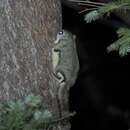en
names in breadcrumbs


Data on ccommunication in P. momonga is lacking, but this species probably relies mainly on vocal communication, such as chittering noises. This would make them like other flying squirrels.
Mothers keep their young in a tree nest for at least six weeks, and it is likely that there are some forms of tactile communication occurring in that context.
Communication Channels: tactile ; acoustic
Perception Channels: visual ; tactile ; acoustic ; chemical
There hasn't been any analysis done to determine biodiversity or conservation for P. momonga.
US Migratory Bird Act: no special status
US Federal List: no special status
CITES: no special status
IUCN Red List of Threatened Species: least concern
No species-specific development information is available, but the following is a general pattern in flying squirrels. The young squirrel is naked at birth, with blood vessels and internal organs visible through the skin. The pup is born completley helpless, relying on its mother for food. After a week, the skin darkens and short hairs begin to develop. Some babies can right themselves at this age. At two weeks old, more fur develops, the toes are separated, and the ear canals begin to open. The infant is soon able to move its tail and facial whiskers voluntarily. At three weeks lateral hairs begin to develop on the tail and the baby responds to loud noises. At four weeks, the baby is completely furry, and the eyes open. They move about energetically and sample food that the mother brings. At five weeks they start some exploration outside of the nest (Wells-Gosling, 1985).
This species does not adversley affect humans, since it resides in forested landscapes where it seldom comes into contact with people.
Flying squirrels throughout the world have been marketed in the pet trade and used for their fur.
Positive Impacts: pet trade ; body parts are source of valuable material
Since P. momonga eats pine seeds, it most likely serves as a seed disperser for pine species. It may also be impotant in local food webs.
Ecosystem Impact: disperses seeds
The diet of Japanese flying squirrels consists of nuts, pine seeds, the buds and bark of certain trees, fruits, and probably some insects. Their forepaws may play only a supplemental role in holding food, which was exhibited by a study done using bait to observe how the species eats in comparison to others. The study also found that when the squirrels were on a perch, they had to turn their bodies sideways in order to bring food to the mouth.
Animal Foods: insects
Plant Foods: leaves; wood, bark, or stems; seeds, grains, and nuts; fruit; flowers
Primary Diet: herbivore (Frugivore , Granivore , Lignivore)
Pteromys momonga, also known as the Japanese flying squirrel, is found on Honshu and Kyushu Islands.
Biogeographic Regions: palearctic (Native )
Other Geographic Terms: island endemic
The habitat of this species consists of boreal evergreen forests. On a smaller spatial scale, they locate their nests (composed of moss or lichen) at the junction of a branch and the trunk of a tree, particularly pine or spruce.
Habitat Regions: temperate
Terrestrial Biomes: forest ; rainforest
No information was found specifically for P. momonga, but other flying squirrels usually live 4 to 5 years.
The head and body length of P. momonga is 120 to 228 mm, and the tail length is between 108 and 127 mm. The mass of these animals has not been reported, and no sexual dimorphism has been described. Their coloration is a silvery to buffy gray on the dorsal surface, and a buffy white on the ventral surface. The gliding membrane extends from the ankles to the wrists, but they lack a membrane between the hind legs and the base of the tail. They blend so well with the coloration of the tree bark that they practically become invisible.
Range length: 120 to 228 mm.
Sexual Dimorphism: sexes alike
Other Physical Features: endothermic ; bilateral symmetry
Specific predators for P. momonga have not been reported. However, as small, nocturnal mammals, they are probably subject to predation by owls.
Japanese flying squirrels posses several features which are adapted to avoid predators. Their cryptic coloration helps them blend into their environment, so that they are less easily detected by predators. They also lie so flat against the tree that they look like an inconspicuous lump on the bark. It is thought that their erratic, quick movements help them to avoid predators also. In addition, they might use their gliding ability to escapre from predators.
Anti-predator Adaptations: cryptic
The mating system of these animals has not been reported.
A pair of adults usually shares a nest. There is a gestation period of approximately 4 weeks. Birth of the young occurs predominantly in May, but in June or early July, a second litter is often produced. There can be a range of 1 to 5 young per litter, with an average of 2 or 3. The young are weaned after 6 weeks.
Breeding interval: These animals apparently breed once or twice annually.
Breeding season: P. momonga is reported to breed from May through July.
Range number of offspring: 1 to 5.
Average number of offspring: 2 or 3.
Average gestation period: 4 weeks.
Average weaning age: 6 weeks.
Key Reproductive Features: iteroparous ; seasonal breeding ; gonochoric/gonochoristic/dioecious (sexes separate); sexual ; viviparous
Details of the parental behavior of this species have not been reported. Young sciurids are typically altricial. The mother nurses the young for approximately six weeks, and presumably grooms and otherwise cares for them during that time. It is not known what role the male may play in parental care.
Parental Investment: altricial ; pre-weaning/fledging (Provisioning: Female)